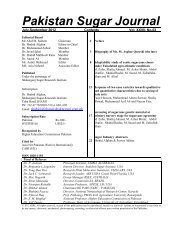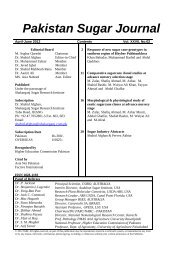Sep to Oct 2006 - Shakarganj
Sep to Oct 2006 - Shakarganj
Sep to Oct 2006 - Shakarganj
You also want an ePaper? Increase the reach of your titles
YUMPU automatically turns print PDFs into web optimized ePapers that Google loves.
etter alternative for the revival of the industry in distant cane-growing areas of Sri Lanka. But<br />
further studies are required <strong>to</strong> find ways of minimising costs of production of the sugarcane- based<br />
products <strong>to</strong> make them more viable home-business ventures.<br />
AGRICULTURE<br />
Agronomy<br />
Forecasting South Africa's sugarcane crop with the canesim crop model<br />
A. Singels1and C.N. Bezuidenhout<br />
Proc. Int. Soc. Sugar Cane Technol., 25: 184-191<br />
Forecasts of the size of the sugarcane crop provide essential information for the industry <strong>to</strong><br />
optimize sugarcane milling and sugar selling. The aim of this paper is <strong>to</strong> briefly describe a modelbased<br />
operational system <strong>to</strong> forecast sugarcane yields and <strong>to</strong> report on the accuracy of forecasts.<br />
Data from approximately 70 weather and rainfall stations are used <strong>to</strong> simulate crops for each month<br />
of the milling season. Seasonal rainfall outlooks are used <strong>to</strong> generate likely future weather data.<br />
Mean yields are calculated for homogenous climate zones, mill areas and the industry and<br />
expressed as a percentage of the yield of the previous year. The accuracy of forecasts was<br />
determined by comparing estimates with actual data from 1980 <strong>to</strong> 2003. Forecast error is due <strong>to</strong> (1)<br />
inaccuracies inherent <strong>to</strong> the system (system error) and <strong>to</strong> (2) uncertainties associated with climate<br />
forecasts. System error was calculated as the root mean square deviation between estimated and<br />
actual yields expressed as a percentage of actual yields. The system error was 5% for industry<br />
average yield. The average error for mill average yield estimates was 11%. System errors were<br />
lower than the inter-annual variation in actual yields for 13 out of 15 mills, suggesting that<br />
estimates should be useful <strong>to</strong> industry and mill management. Results suggest that further<br />
improvements are needed <strong>to</strong> estimate yields for irrigated mill areas, but that estimates for most dryland<br />
areas are sufficiently accurate <strong>to</strong> be of value <strong>to</strong> mill management. Early season operational<br />
model forecasts of industry average yield outperformed conventional forecasts in three of the past<br />
four seasons.<br />
Early-season predictions of sugarcane yield in Florida, USA<br />
T.R. Sinclair, R.A. Gilbert, J. M. Shine, Jr and R.E. Perdomo<br />
Proc. Int. Soc. Sugar Cane Technol., 25: 192-197<br />
Schedules for harvest and milling operations are initiated well in advance of the actual harvest.<br />
Yield estimates are a critical component of this planning and currently these estimates are generally<br />
based on observations by experienced scouts. This study was undertaken <strong>to</strong> supplement and <strong>to</strong><br />
improve these yield predictions by developing a hybrid forecast scheme based on a combination of<br />
mechanistic crop modeling and empirical correlations with yield his<strong>to</strong>ry. An early season forecast<br />
of yield (1 st May for harvesting initiated in the following November) was developed and based on<br />
the influence of temperature on leaf development of young sugarcane plants. Regression of<br />
cumulative temperature (base temperature= 10°C) for the period between 15 th January and 30 th<br />
April for 34 years from 1963 <strong>to</strong> 1996 against the subsequent yield in each season resulted in a<br />
significant correlation (r 2 = 0.69). A forecast made on 1 st August was based on the amount of solar<br />
radiation intercepted by the crop up <strong>to</strong> that point. Again, a significant correlation was obtained (r 2 =<br />
0.60), but this later forecast was not superior <strong>to</strong> the early season forecast. Two crucial issues were<br />
identified in the analysis of these data. First, an early season frost had a large impact on yield that<br />
could be accounted for by resetting the tabulation of cumulative temperature and cumulative<br />
14






